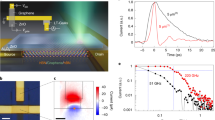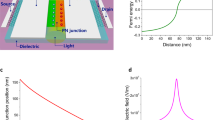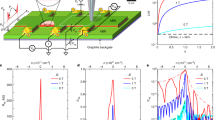Abstract
Exploiting the light-like properties of carriers in graphene could allow extreme non-classical forms of electronic transport to be realized1,2,3,4,5,6,7,8. In this vein, finding ways to confine and direct electronic waves through nanoscale streams and streamlets, unimpeded by the presence of other carriers, has remained a grand challenge9,10,11,12. Inspired by guiding of light in fibre optics, here we demonstrate a route to engineer such a flow of electrons using a technique for mapping currents at submicron scales. We employ real-space imaging of current flow in graphene to provide direct evidence of the confinement of electron waves at the edges of a graphene crystal near charge neutrality. This is achieved by using superconducting interferometry in a graphene Josephson junction and reconstructing the spatial structure of conducting pathways using Fourier methods13. The observed edge currents arise from coherent guided-wave states, confined to the edge by band bending and transmitted as plane waves. As an electronic analogue of photon guiding in optical fibres, the observed states afford non-classical means for information transduction and processing at the nanoscale.
This is a preview of subscription content, access via your institution
Access options
Subscribe to this journal
Receive 12 print issues and online access
$259.00 per year
only $21.58 per issue
Buy this article
- Purchase on SpringerLink
- Instant access to full article PDF
Prices may be subject to local taxes which are calculated during checkout




Similar content being viewed by others
References
Castro Neto, A. H., Guinea, F., Peres, N. M. R., Novoselov, K. S. & Geim, A. K. The electronic properties of graphene. Rev. Mod. Phys. 81, 109–162 (2009).
Katsnelson, M. I., Novoselov, K. S. & Geim, A. K. Chiral tunnelling and the Klein paradox in graphene. Nature Phys. 2, 620–625 (2006).
Young, A. F. & Kim, P. Quantum interference and Klein tunnelling in graphene heterojunctions. Nature Phys. 5, 222–226 (2009).
Campos, L. et al. Quantum and classical confinement of resonant states in a trilayer graphene Fabry–Perot interferometer. Nature Commun. 3, 1239 (2012).
Varlet, A. et al. Fabry–Pérot interference in gapped bilayer graphene with broken anti-Klein tunneling. Phys. Rev. Lett. 113, 116601 (2014).
Cheianov, V. V., Fal’ko, V. & Altshuler, B. L. The focusing of electron flow and a Veselago lens in graphene p–n junctions. Science 315, 1252–1255 (2007).
Shytov, A. V., Rudner, M. S. & Levitov, L. S. Klein backscattering and Fabry–Perot interference in graphene heterojunctions. Phys. Rev. Lett. 101, 156804 (2008).
Mayorov, A. S. et al. Micrometer-scale ballistic transport in encapsulated graphene at room temperature. Nano Lett. 11, 2396–2399 (2011).
Pereira, J. M., Mlinar, V., Peeters, F. M. & Vasilopoulos, P. Confined states and direction-dependent transmission in graphene quantum wells. Phys. Rev. B 74, 045424 (2006).
Zhang, F.-M., He, Y. & Chen, X. Guided modes in graphene waveguides. Appl. Phys. Lett. 94, 212105 (2009).
Hartmann, R. R., Robinson, N. J. & Portnoi, M. E. Smooth electron waveguides in graphene. Phys. Rev. B 81, 245431 (2010).
Williams, J. R., Low, T., Lundstrom, M. S. & Marcus, C. M. Gate-controlled guiding of electrons in graphene. Nature Nanotech. 6, 222–225 (2011).
Dynes, R. C. & Fulton, T. A. Supercurrent density distribution in Josephson junctions. Phys. Rev. B 3, 3015–3023 (1971).
Taychatanapat, T., Watanabe, K., Taniguchi, T. & Jarillo-Herrero, P. Electrically tunable transverse magnetic focusing in graphene. Nature Phys. 9, 225–229 (2013).
Ritter, K. A. & Lyding, J. W. The influence of edge structure on the electronic properties of graphene quantum dots and nanoribbons. Nature Mater. 8, 235–242 (2009).
Tao, C. et al. Spatially resolving edge states of chiral graphene nanoribbons. Nature Phys. 7, 616–620 (2011).
Oostinga, J. B., Heersche, H. B., Liu, X., Morpurgo, A. F. & Vandersypen, L. M. K. Gate-induced insulating state in bilayer graphene devices. Nature Mater. 7, 151–157 (2007).
Bischoff, D., Libisch, F., Burgdrfer, J., Ihn, T. & Ensslin, K. Characterizing wave functions in graphene nanodevices: Electronic transport through ultrashort graphene constrictions on a boron nitride substrate. Phys. Rev. B 90, 115405 (2014).
Barone, A. & Paterno, G. Physics and Applications of the Josephson Effect (John Wiley, 1982).
Dean, C. R. et al. Boron nitride substrates for high-quality graphene electronics. Nature Nanotech. 5, 722–726 (2010).
Tinkham, M. Introduction to Superconductivity (McGraw-Hill, 1975).
Cuevas, J. C. & Bergeret, F. S. Magnetic interference patterns and vortices in diffusive SNS junctions. Phys. Rev. Lett. 99, 217002 (2007).
Hui, H.-Y., Lobos, A. M., Sau, J. D. & Sarma, S. Das Proximity-induced superconductivity and Josephson critical current in quantum spin Hall systems. Phys. Rev. B 90, 224517 (2014).
Jaklevic, R. C., Lambe, J. & Mercereau, J. E. Quantum interference effects in Josephson tunneling. Phys. Rev. Lett. 12, 159–160 (1964).
McCann, E. Asymmetry gap in the electronic band structure of bilayer graphene. Phys. Rev. B 74, 161403 (2006).
Castro, E. V. et al. Biased bilayer graphene: Semiconductor with a gap tunable by the electric field effect. Phys. Rev. Lett. 99, 216802 (2007).
Jackiw, R. & Rebbi, C. Solitons with fermion number. Phys. Rev. D 13, 3398–3409 (1976).
Silvestrov, P. G. & Efetov, K. B. Charge accumulation at the boundaries of a graphene strip induced by a gate voltage: Electrostatic approach. Phys. Rev. B 77, 155436 (2008).
Nakada, K., Fujita, M., Dresselhaus, G. & Dresselhaus, M. S. Edge state in graphene ribbons: Nanometer size effect and edge shape dependence. Phys. Rev. B 54, 17954–17961 (1996).
Akhmerov, A. R. & Beenakker, C. W. J. Boundary conditions for Dirac fermions on a terminated honeycomb lattice. Phys. Rev. B 77, 085423 (2008).
Castro, E. V., Peres, N. M. R., dos Santos, J. M. B. L., Neto, A. H. C. & Guinea, F. Localized states at zigzag edges of bilayer graphene. Phys. Rev. Lett. 100, 026802 (2008).
Allen, M. T. et al. Visualization of phase-coherent electron interference in a ballistic graphene josephson junction. Preprint at http://arxiv.org/abs/1506.06734 (2015).
Xiao, D., Yao, W. & Niu, Q. Valley-contrasting physics in graphene: Magnetic moment and topological transport. Phys. Rev. Lett. 99, 236809 (2007).
Jung, J., Zhang, F., Qiao, Z. & MacDonald, A. H. Valley-Hall kink and edge states in multilayer graphene. Phys. Rev. B 84, 075418 (2011).
Zhang, F., MacDonald, A. H. & Mele, E. J. Valley Chern numbers and boundary modes in gapped bilayer graphene. Proc. Natl Acad. Sci. USA 110, 10546–10551 (2013).
Alden, J. S. et al. Strain solitons and topological defects in bilayer graphene. Proc. Natl Acad. Sci. USA 110, 11256–11260 (2013).
Acknowledgements
The authors thank O. Dial, B. Halperin, V. Manucharyan and J. Sau for helpful discussions. This work is supported by the Center for Integrated Quantum Materials (CIQM) under NSF award 1231319 (L.S.L. and O.S.) and the US DOE Office of Basic Energy Sciences, Division of Materials Sciences and Engineering under award DE-SC0001819 (P.J.-H., M.T.A., A.Y.). Nanofabrication was performed at the Harvard Center for Nanoscale Systems (CNS), a member of the National Nanotechnology Infrastructure Network (NNIN) supported by NSF award ECS-0335765. A.R.A. was supported by the Foundation for Fundamental Research on Matter (FOM), the Netherlands Organization for Scientific Research (NWO/OCW). I.C.F. was supported by the European Research Council under the European Union’s Seventh Framework Programme (FP7/2007–2013)/ERC Project MUNATOP, the US–Israel Binational Science Foundation, and the Minerva Foundation.
Author information
Authors and Affiliations
Contributions
M.T.A. and A.Y. designed and fabricated the devices, performed the experiments, analysed the data, and wrote the paper. O.S. and L.S.L. developed the theoretical model of guided edge modes and wrote the paper. A.R.A. and I.C.F. performed the Bayesian analysis of the Fraunhofer patterns. P.J.-H. contributed to discussions of the results and wrote the paper. K.W. and T.T. provided the hexagonal boron nitride crystals used in device fabrication.
Corresponding author
Ethics declarations
Competing interests
The authors declare no competing financial interests.
Supplementary information
Supplementary information
Supplementary information (PDF 1507 kb)
Rights and permissions
About this article
Cite this article
Allen, M., Shtanko, O., Fulga, I. et al. Spatially resolved edge currents and guided-wave electronic states in graphene. Nature Phys 12, 128–133 (2016). https://doi.org/10.1038/nphys3534
Received:
Accepted:
Published:
Issue date:
DOI: https://doi.org/10.1038/nphys3534
This article is cited by
-
Supercurrent mediated by helical edge modes in bilayer graphene
Nature Communications (2024)
-
Evidence for 4e charge of Cooper quartets in a biased multi-terminal graphene-based Josephson junction
Nature Communications (2022)
-
Hydrodynamic approach to two-dimensional electron systems
La Rivista del Nuovo Cimento (2022)
-
Long-range nontopological edge currents in charge-neutral graphene
Nature (2021)
-
Giant intrinsic photoresponse in pristine graphene
Nature Nanotechnology (2019)



